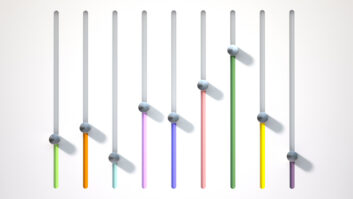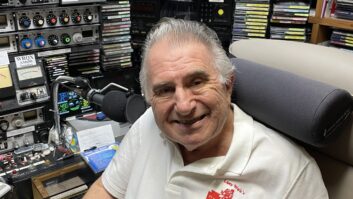When ATC/Collins introduced the cart machine at the 1959 NAB Show in Chicago, it revolutionized radio. Along with the 45 rpm record, the cart machine made the top 40 format possible.

Over four decades, the technology was tweaked and refined. Precision-manufactured cartridges, high-bias tape and stereo cart decks were among the milestones.
The digital audio revolution of the ’90s marked the beginning of the end for the tape cartridge machine, as hard drive storage and playback of digital audio files became the norm. While there is no formal end point for tape cartridge technology, the party was winding down by 1999, giving carts a 40-year run.
This installment of Plugging Into the Past looks at the first and last models of cart machines manufactured by Broadcast Electronics. While ATC/Collins generally is credited with selling the first cart machines, the P-series, Broadcast Electronics is acknowledged as a close second.
About the same time that Fred L. “Ted” Bailey and John P. “Jack” Jenkins were developing the ATC machine at WJBC in Bloomington, Ill., Ross Beville of WWDC (now WWRC) in Washington, D.C., was working on the Spotmaster. The two parties apparently were unaware of each other until Beville saw the ATC machine at the 1959 NAB Show.
Broadcast Electronics was founded in June 1959, and the first production runs of the legendary 500 series were assembled in the WWDC garage. The first machines were shipped in wooden cases; BE’s familiar blue hammertone aluminum ones came later. The first employees were Austin Knox, engineer, and Jack Neff, sales.
While cart machines were the mainstay of the early BE, they did branch out into cart accessories, such as cart tape winders and various types of cart storage racks. Starting in the mid-1960s, they also manufactured four-channel remote broadcast consoles and turntable preamps, although the marketing strategy seems to have been keeping their existence a secret. Apart from a few ads in the Journal of College Radio, they were never really advertised, and few were sold.
THE COMPETITION
Despite the huge success of the ATC/Collins cart machine at the 1959 NAB Show and subsequent production of machines by BE, the future of the endless loop tape format was by no means guaranteed — there were competitors.
Perhaps best remembered was the Gates ST-101. It used a tape belt 13 inches wide and divided into 101 tracks, each having a maximum time of 90 seconds, with HF response topping out at 8 kHz.

RCA developed a similar wide-belt machine that never went into production.
The name Schafer is best remembered for automation systems, but it also made the Schafer Spotter, a modified reel-to-reel machine with photo cell detectors. It would count the passage of sections of clear leader tape to cue to the proper cut.
Ultimately, none of these or other competitors gained a foothold in the market, and the cart machine prevailed.
SPOTMASTER 500
The genius of the Spotmaster 500 was its simplicity of design. While there were many cosmetic facelifts over the years, and electronic components were upgraded, the transport itself remained virtually unchanged. It started with a Viking transport with either a Pabst or Hurst motor along with a flywheel-belt drive. The first machines had an 850 Hz cue track, which was changed to 1 kHz early in production.
Unlike its competitor the ATC, which automatically engaged the pinch roller, the Spotmaster had a load lever to bring the pinch roller in place and used a smaller solenoid to engage when the machine was started.
Hybrid electronics were unique to the first-generation 500s. The 1 kHz cue detector and playback amp were solid-state, while the 1 kHz cue tone generator, bias oscillator and record amp had vacuum tubes. A combination of 12AX7s, 12AU7s and 12AV6s were used in the record circuits, while all transistors in the playback electronics were 2N217s.

Also unique to these premier machines was the location of controls and connectors along the sides. This turned out to be a bad idea for two reasons. First, the spring-loaded start lever switch was easily damaged and bent; second, the configuration made it impossible to mount machines side by side.
The 500 series continued to evolve into the A, B, C and D models from 1959 through the early 1980s, when it was replaced by the 10-70 series, although BE continued to make the multi-deck versions of the 500, 605 and 610. The 10-70s were designed and built during the time when BE was owned by Filmways Corp.
2100C
In 1987 the BE 2100C series machines are introduced. They are about as advanced as the 500 was primitive and would remain in production until Broadcast Electronics ceased manufacture of cart machines in 1995. The 2100C was available in both mono and stereo playback and record versions. Primary (1 kHz) and secondary (150 Hz) cue tone circuitry was standard. An automatic mono/stereo switching feature was included in the stereo machines. Most of the audio circuitry is designed around 4558 and 4559 ICs, while the logic circuits run on 74XX TTL chips.
There are two circuit boards that plug into a motherboard on the 2100C. The playback logic board contains all the deck control logic, playback amp and cue detector circuitry. The record circuit board houses the record control logic, record amp and cue tone generator circuitry. The circuit boards are double-sided with through-hole components.
The motherboard has the internal circuit connections and the robust +18, +15, +3.6 and –5.6 volt power supplies.
The cart deck is made of half-inch machined aluminum. It has an air-damped solenoid, direct-drive hysteresis-synchronous motor and the Phase Lok V head assembly.
TECHNOLOGICAL ADVANCES
One of the best ways to get a sense of the advances in tape cartridge technology is to look at the tools and procedures for maintenance. For the 500 there were no tweaks for the playback amp or cue detector. The only alignment tool provided was the head adjustment wrench. The procedure was to slowly rock the head with the wrench while playing back the azimuth alignment track. When the peak was reached, the rear nut was tightened with a small crescent wrench. In the process, the head height could shift, and the entire procedure was never very precise. BE later introduced a head stack for the 500s that had Allen wrench adjustments for height and azimuth, ensuring a more accurate alignment.

Special tools were needed for adjustments to the 2100C deck. The direct-drive Nidec motor needed to be positioned so its shaft was perfectly tangent to the pinch roller, and this was accomplished with an alignment gauge. It looked like a steel pinch roller, and when it was in place, the motor could be precisely located and secured.
For coarse head adjustment, a guide was used to check the height of the tape guide, head height and head zenith. Final adjustment was made using an alignment cart and oscilloscope. The electronic alignment consisted of setting playback levels, EQ and cue sensitivity. Record adjustments included adjusting the bias traps, bias level, record EQ, cue bias and cue record level.
BLAST FROM THE PAST
The date code on the back of the 500 shown here indicates it is a very early model, manufactured in August of 1960. It was found in the engineering shop of a Boston radio station in the back of a filing cabinet; it had been used to keep file folders from falling down the back. The original instruction manual was also found. The numerous dings and dents on the chassis suggest that it had a hard life, although it does work.
Both of the pictured 2100Cs were discovered in the closet of a college radio station about 10 years ago and were manufactured in 1989. They had been taken out of service when the station went over to a hard drive playback system. During their service life, they had suffered from considerable neglect, and needed a thorough cleaning.
Even though the 500 is approaching the 60-year mark, complete restoration is fairly straightforward since it was made from off-the-shelf components, and spare transport parts are on hand.
While the 2100s are newer, they have their own challenges. The pinch rollers were made of a miracle rubber that would not get slick and harden with age. With the passage of 30 years, however, the material cracks and takes on the consistency of gummy bears. The only option appears to be having them remanufactured.
Tom Vernon is a longtime RW contributor.







